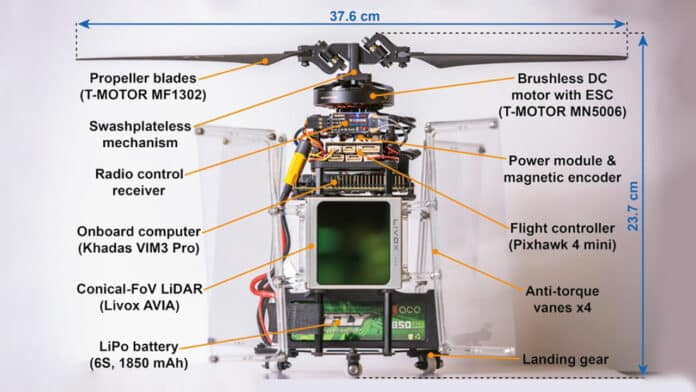Uncrewed aerial vehicles (UAVs) are already playing an increasingly vital role in search and rescue, cave surveying, and architectural mapping. UAVs rely heavily on visual sensors to perceive obstacles and explore environments. Current UAVs are limited in both perception capability and task efficiency because of a small sensor field of view (FoV).
Engineers at the University of Hong Kong (HKU) have developed a Powered-flying Ultra-underactuated LiDAR-Sensing Aerial Robot (PULSAR) that is poised to redefine the world of unpiloted aerial vehicles (UAVs).
With a micro-computer and a LiDAR sensor, PULSAR boasts full onboard perception, mapping, planning, and control capabilities in both indoor and outdoor environments, all without requiring any external instruments.
PULSAR uses only a single actuator, which powers the swashplate-less mechanism and provides both thrust and moment. Through a series of experiments, the research team demonstrated PULSAR’s ability to detect static and dynamic obstacles in real-time, track complex trajectories, and navigate autonomously even in complete darkness.
PULSAR’s robustness also extends to withstanding external wind disturbances, enabling safer and more stable flights in unpredictable conditions. The aerial robot can maintain its hover position within a small area at a maximum wind speed of 4.5 m/s. This enables a safer and more stable flight in a wild environment.
In addition to its aforementioned capabilities, the sensor can extend the field of view (FoV) through self-rotation motion, enhancing the UAV’s perception and task efficiency.
According to the researcher, the invention of PULSAR can save 26.7% of energy consumption compared to a quadrotor UAV with the same propeller disk area and avionic payloads while retaining good agility.
Thanks to its single-actuator propulsion system, PULSAR experiences less energy conversion loss, resulting in a high flight efficiency of 6.65g/W. The UAV has a diameter of only 37.6 cm and a battery capacity of just 41 Wh. Despite its small size, this 1234-g UAV achieved a hover time of over 12 minutes. By removing the LiDAR sensor and installing a larger propeller and battery, the hover time of PULSAR can be extended to more than 40 minutes.
“We believe that it will facilitate the research of UAV control methods under high-speed rotation and simultaneous localization and mapping (SLAM) techniques under aggressive motion,” said lead researcher Dr. Fu Zhang.
Journal reference:
- Nan Chen, Fanze Kong, Wei Xu, Yixi Cai, Haotian Li, Dongjiao He, Youming Qin, Fu Zhang. A self-rotating, single-actuated UAV with an extended sensor field of view for autonomous navigation. Science Robotics, 2023; DOI: 10.1126/scirobotics.ade4538
